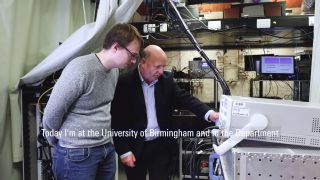Electronic Design - Quantum / case study
QUANTUM - ENABLED RADAR RESEARCH
Finding the right solution for the University of Birmingham
When the UK Quantum Technology Hub needed high-precision quantum clocks, they turned to Rohde&Schwarz for test and measurement expertise.
Led by the University of Birmingham, the UK Quantum Technology Hub’s Sensors and Timing project develops quantum clocks for precision radar and other applications such as map-matching navigation and gravitational sensing. The Universities of Glasgow, Strathclyde, Sussex, Imperial College London, Nottingham and Southampton are also partnering in the work, as are the National Physics Laboratory (NPL) and the British Geological Survey (BGS).
The goal of the UK Quantum Technology Hub is to develop highprecision radar to detect relatively small, slow-moving objects such as drones and even migrating birds. Whereas conventional radar technology struggles with this task due to its limited resolution and inability to capture identifiable images in sharp focus, quantum technology promises better results but requires high precision. This is where Rohde&Schwarz expertise comes in.
To assess their quantum clocks, the team needed to measure the performance of high precision oscillators on which the quantum clocks are based. The research team is engineering precision quantum oscillators to provide clean, sharp timing signals at frequencies up to 10 GHz. Since quantum clock technology is based on high-precision instruments, it is important to ensure their accuracy with thorough testing using instruments capable of matching the precision of the radar.
For this purpose, the team selected the R&S®FSWP phase noise analyzer and VCO tester. The team selected this solution as their go-to instrument for its capability to take very high sensitivity phase noise measurements on various types of signals, including pulsed signals, which made it ideal for the task.







